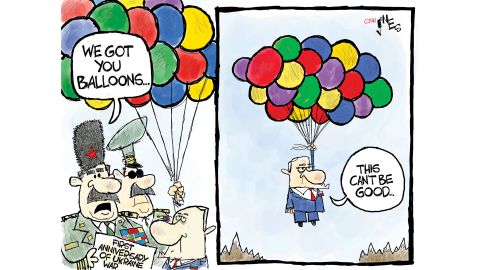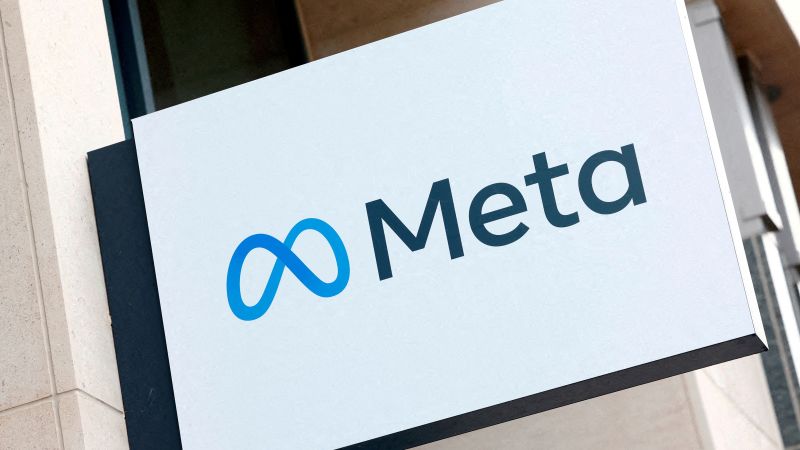Editor’s Note: Sign up to get this weekly column as a newsletter. We’re looking back at the strongest, smartest opinion takes of the week from CNN and other outlets.
CNN
—
When Nazi Germany attacked the Soviet Union on June 22, 1941, dictator Joseph Stalin was too shocked to speak in public for nearly two weeks.
On July 3, he finally gave a radio speech, trying to reassure his nation — already suffering serious battlefield losses to the German blitzkrieg — with the words, “History shows that there are no invincible armies.”
Germany’s “Operation Barbarossa” involved more than 3 million troops, about 3,000 tanks and 2,500 aircraft — one of the largest invasion forces in history. Expecting to conquer Moscow within weeks, Nazi dictator Adolf Hitler thought the Soviet regime would quickly disintegrate. Over the next four years though, Hitler’s armies proved to be anything but invincible.
One year ago, Stalin’s heir in the Kremlin, Russian President Vladimir Putin, launched an army — one that he likely thought was invincible — into Ukraine, aiming to quickly decapitate its leadership and seize Kyiv. His hopes were frustrated by Ukraine’s spirited defense under President Volodymyr Zelensky, and the two nations continue to be locked in a savage conflict.
Contrary to what most people expected before the war, it’s a stalemate, observed retired US General David Petraeus, in a Q&A with CNN National Security Analyst Peter Bergen. So how does the Russian leader look a year after his decision?
“Putin has earned a failing grade to date,” said Petraeus, who commanded the US wars in Afghanistan and Iraq. “Let’s recall that the first and most important task of a strategic leader is to ‘get the big ideas right’ — that is, to get the overall strategy and fundamental decisions right. Putin clearly has failed abysmally in that task, resulting in a war that has made him and his country a pariah, set back the Russian economy by a decade or more (losing many of Russia’s best and brightest, and prompting over 1,200 western companies to leave Russia or reduce operations there), done catastrophic damage to the Russian military and its reputation and put his legacy in serious jeopardy.”
Still, it would be a mistake to underestimate Russia, Petraeus noted, citing a maxim often attributed, perhaps wrongly, to Stalin: “Quantity has a quality of its own.”
During World War II, the Soviet Union’s ability to call on vast reserves and sustain enormous casualties, despite having inferior tanks and planes, helped it to defeat Germany.
Today, Russia’s population is more than three times the size of Ukraine’s and it can afford to send more soldiers into the fight. But in Ukraine’s case there’s an intangible factor. “Ukrainians know what they are fighting for,” Petraeus noted, “while it is not clear that the same is true of many of the Russian soldiers, a disproportionate number of whom are from ethnic and sectarian minorities in the Russian Federation.”
On February 23, 2022, Diliara Didenko, went to bed in Zaporizhzhia, Ukraine, “thinking that I would celebrate my husband’s birthday the next day. Our life was getting better. My husband was running his own business. Our daughter had started school and made friends there. We were lucky to have arranged support services and found a special needs nursery for our son. I finally had time to work. I felt happy.”
She had no inkling that the outbreak of war would force her to restart her life in the Czech Republic within 22 days.
“Completely exhausted, crushed and scared, we had to brace ourselves and come to terms with our forced displacement. I will be forever grateful to all those who helped us come to Prague and adjust to a new life in a foreign land.” Didenko’s is one story among the tens of millions of lives displaced, disrupted or cut short by the war.
For more:
Frida Ghitis: Break up the Xi Jinping-Vladimir Putin partnership
Cristian Gherasim: Moldova isn’t on the front page, but it could be in Putin’s crosshairs
Growing up near Michigan State University’s campus “was the stuff of childhood dreams,” recalled CNN Opinion’s Kirsi Goldynia. On quiet summer evenings, she would “sit outside the MSU Dairy Store licking an ice cream cone … I was safe in this community where we looked out for one another. I had space to run and play, to grow and imagine and learn.”
“Since moving away from home, those childhood memories have moored me to the place where I grew up, where life felt simple and the world felt kind,” she observed. “On Monday night, when news broke that there was an active shooter on Michigan State’s campus, I clung to those memories.”
Goldynia’s mother was among those locked down for hours when a shooter killed three people and injured five more. The news alarmed those on campus and rippled out to the enormous alumni network of MSU, which has about 50,000 current students.
“I think about the words Michigan Gov. Gretchen Whitmer spoke on Tuesday morning — ‘Our Spartan community is reeling today’ — and I wonder if the ‘reeling’ ever ends and, if it does, what comes afterward,” Goldynia wrote.
In the Detroit Free Press, Jemele Hill, who graduated from MSU, wrote, “What happened … is a reminder that the regularity of these acts is bringing violence even closer to all of us. Some of the students whom Americans saw struggling to process what happened had already lived through another mass shooting — in Oxford, or Newtown, Conn. Many of the students who fled certain buildings on campus the night of the shooting were just following the protocols they’d been taught prior to coming to Michigan State, because teaching children and young adults how not to be killed in mass shootings is now a staple of America’s egregious routine.”
For more on guns:
Jens Ludwig and Chico Tillmon: There’s no safety net to catch the young men at highest risk of gun violence
Now there’s more than one. For months, former President Donald Trump was the only candidate for the 2024 Republican presidential nomination. This week, Nikki Haley, the former South Carolina governor and US ambassador to the UN, entered the fray, saying, “We are more than ready for a new generation to lead us into the future.”
As SE Cupp noted, Haley called for going beyond the “faded names of the past” and argued for term limits for members of Congress and “mandatory mental competency tests for politicians over 75 years old.” Trump is 76 and President Joe Biden is 80.
But the real question, in Cupp’s view, is this: “Will Haley also bring substantively different views that appeal to younger generations?”
“Will she break with the election denialism, grievance politics, white nationalism and conspiracy theories that Trumpism allowed?” And, Cupp added, where will Haley stand on immigration, gun control, climate change, abortion and other issues that particularly resonate with younger voters?
For more:
Gavin Smith: Nikki Haley is an excellent 2024 GOP candidate
Issac Bailey: Nikki Haley is a poor 2024 GOP candidate
A report Thursday from a special grand jury in Georgia offered a fresh refutation of Trump’s already discredited claim of massive fraud in the 2020 election. As Jill Filipovic pointed out, the jurors, who likely included some Trump voters, “were asked to assess whether it’s possible that a former president and his allies had leveraged an attack on American democracy, or whether that president was telling the truth when he said the election was stolen.”
In a unanimous conclusion, “they found that, contrary to the former president’s claims, there was no evidence of widespread fraud undermining the results of the election, and that at least some criminal charges should be brought.”
“If average people selected for a special grand jury can complete this task with honesty and integrity, surely it’s not asking too much for Republican officeholders to approach their roles with similar gravity: To declare that the election was free and fair, and to ask that those who may have broken the law or lied be held accountable,” wrote Filipovic.
A court filing the same day in the libel lawsuit brought by Dominion Voting Systems against Fox News revealed more damning information. Writing in CNN’s Reliable Sources newsletter, Oliver Darcy observed, “Despite what the right-wing talk channel peddled to its millions of loyal viewers in the immediate aftermath of the 2020 election, behind the scenes its most prominent stars and highest-ranking executives privately trashed claims of election fraud.”
The derailment that left 20 cars of hazardous materials in the village of East Palestine, Ohio, more than two weeks ago is still a huge concern for residents seeking answers.
Judith A. Lennington, a factory worker turned book author and a longtime resident, saw the effects of the disaster from her farm three miles away.
“The cloud that went up in the sky was like nothing I’ve ever seen in my life,” she told CNN Opinion’s Stephanie Griffith. “It looked like a huge black cloud with a tornado coming down from it. It was just awful. After the accident, we put quilts over the doors and over the windows, sealed the cracks and just stayed inside.”
“I can still smell it outside. Luckily the fumes are not strong here — the wind blows in the other direction — but I can, still, if I go from the house to the garage, I can feel my eyes burning. And I lose my voice after a while…”
“So I don’t know what’s going to happen. Is it safe to let your children go out and walk in that grass? Is it safe to let your pets go to the bathroom on the grass and then come back in your house? If your water is safe, what about those ponds where the train wreck is?”
The newly elected Sen. John Fetterman checked himself into Walter Reed National Military Medical Center Thursday for treatment of “clinical depression,” his chief of staff announced. Fetterman, recovering from a stroke during his campaign last year, deserves credit for seeking help and being open about it, wrote psychologist Peggy Drexler.
“We’re right to want to know about the health issues facing our leaders and the steps they’re taking to get the help they need, but it’s important to remember that millions of Americans battle depression and lead highly productive, successful lives. … We’re living in tough times, and almost everybody hurts; if our leaders are meant to represent us, how can we possibly fault them for being, in fact, just like us?”
The episode of the Chinese balloon was followed by an even stranger one: US fighter jets shot down three more objects of so-far unknown origin over the US and Canada. President Biden spoke about the shootdowns for the first time on Thursday, saying that there was no indication the last three were connected to the balloon from China, which US officials said was intended for surveillance.
In January, as Peter Bergen noted, the US intelligence community reported that “the number of UFO sightings significantly increased between March 2021 and August 2022, during which time 247 new sightings were reported, mostly by US Navy and Air Force pilots and personnel. That’s almost double the 144 UFO sightings reported in the 17-year period between 2004 to 2021.” Could the spate of unexplained aircraft have any relation to the ones that were shot down?
“Congress should convene hearings to get to the bottom of this,” Bergen wrote. “The public has a right to understand why objects are flying around in American airspace that the Pentagon and the US intelligence community can’t identify.”
For more:
Julian Zelizer: Biden’s ‘no apologies’ speech should silence his critics.
Svetlana was Joseph Stalin’s “beloved daughter,” Rosemary Sullivan wrote. “Stalin called her his little hostess, little fly, little sparrow. She was the only one who could stop his rages against her mother by wrapping her arms around his Cossack boots.”
But when a considerably older Soviet filmmaker wooed the 16-year-old Svetlana, her father’s reaction was fierce: he sent him to the Gulag for 10 years. “This was when Svetlana began to understand who her father was. Her status as beloved was conditional.”
Her story has new resonance now that North Korean dictator Kim Jong Un appears to be “grooming his daughter to carry on his dynasty. North Korea just released a new postage stamp carrying photos of the dictator and his ‘beloved daughter’ standing together watching the test-firing of the Hwasong-17 intercontinental ballistic missile,” Sullivan noted.
“Will she, like Svetlana, inherit her father’s will but reject his murderous legacy? Or will she prove a well-trained apprentice and possibly become more dangerous than her father?”
The last thing Euny Hong expected to be doing was panicking about getting tickets to an art exhibit. But then she read what she called the “sadistic” headline a “sadistic” friend posted on Facebook:
“There will never be a Vermeer exhibit as great as this one.”
“In the entire world, there are only 35 known paintings by the 17th-century Dutch master, whose legendary use of texture and light, particularly in the portrayal of women in their everyday lives, positions him among the greatest painters of all time,” Hong wrote. The much-anticipated exhibit at Amsterdam’s Rijksmuseum features “28 of his works, including ‘Girl with a Pearl Earring,’ which, by the way, is only on display through March.”
“It was the words ‘there will never be’ that sent me into a frenzy of obsessively refreshing the museum’s web page like a lab rat pushing a heroin lever. The site alternated between crashing and displaying a message that they were ‘temporarily’ suspending ticket sales. And here I thought my lack of Taylor Swift fandom would save me from such indignities!”
Happy ending: Hong landed the tickets.
Sophia A. Nelson: Who will care for the caregivers?
Pratika Katiyar: I’m a GenZ student journalist. We won’t be silenced
Jill FIlipovic: A violent attack with dog feces raises questions all women confront
Raed Al Saleh: It was one of the world’s deadliest catastrophes. Where was the UN?
Gene Seymour: The Super Bowl’s best ad also holds the best advice
Heather Ann Thompson: A university’s sinister move is unfortunately part of a familiar story
Dean Obeidallah: The GOP can’t ignore the blockbuster report on Trump, Kushner and Saudi funds
Peter Svarzbein: The US southern border is not a threat –— it’s an opportunity
Khalil Gibran Muhammad and Erica Licht: Ron DeSantis’s latest salvo against diversity
AND…
Baseball may be considered America’s “national pastime,” but the MLB has been losing fans for years to faster-paced sports leagues like the NBA and NFL. So when spring training games begin later this week, there will be one revolutionary change: a time clock to force pitchers to spend less time between throws.
“For more than 150 years, the lack of a clock on the field has distinguished baseball from other major US team sports, and some baseball purists are sure to object to adding one,” wrote Frederic J. Frommer.
There’s a precedent of sorts. In the early 1950s, interest in professional basketball was declining, prompting the league to introduce a shot clock. “The impact was immediate: average team scoring per game increased from 79 points to 93. That figure rose to 106 by 1958, and not coincidentally, attendance soared by 40%.”
“People don’t come to games to watch guys stand around and do nothing — whether it’s on a basketball court or a baseball diamond,” Frommer observed. “A clock won’t have the same dramatic effect on baseball that it had on the NBA. But for Americans with limitless entertainment options and limited time, it will help attract fans with more exciting (and faster) baseball games than we’ve seen in years.”

























